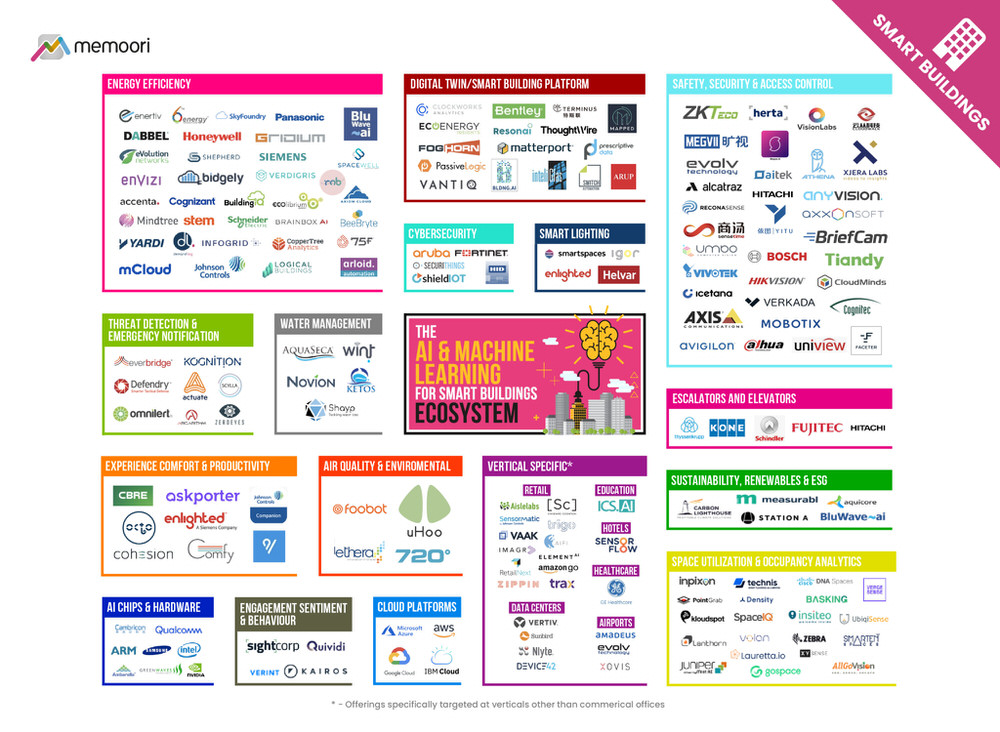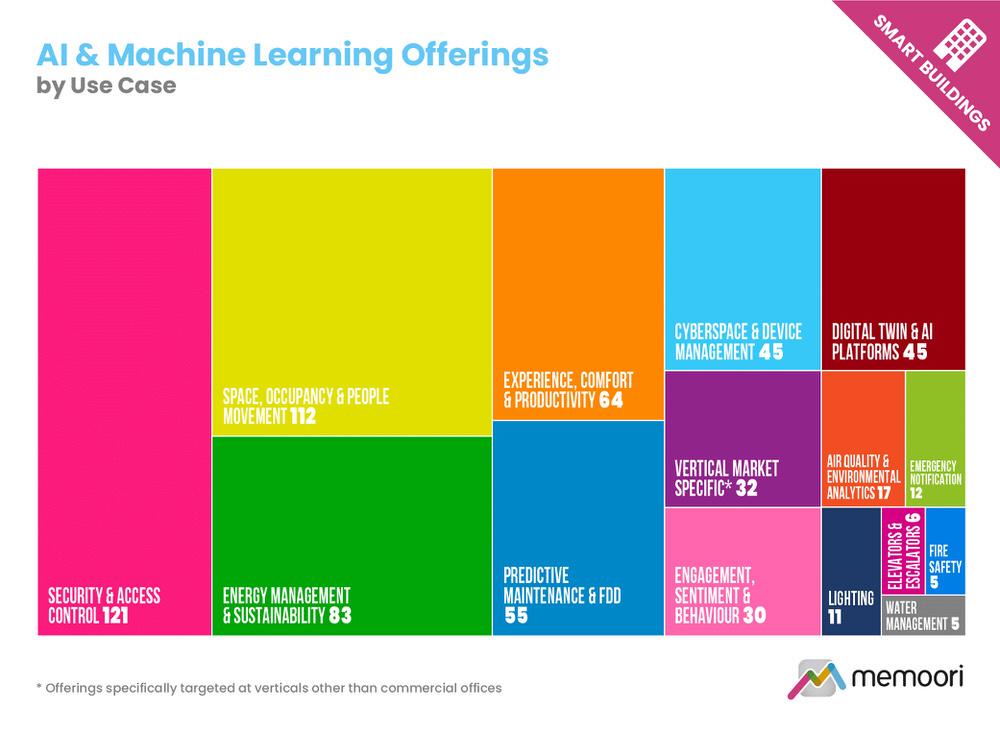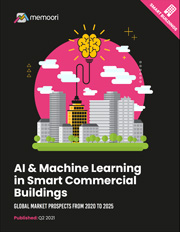
AI & Machine Learning in Smart Commercial Buildings
Global Market Prospects from 2020 to 2025
This Assessment of current and forecast revenues is based on a comprehensive bottom-up model that evaluates the AI and Machine Learning offerings of a total of 255 companies, ranging from the worlds largest Tech firms, to niche Startups based in a total of 17 different countries around the globe.
The insights presented in this report build on our expertise in associated areas of the IoT, Big Data, Cybersecurity, and application specific markets such as Physical Security, Video Analytics, Occupancy Analytics, and Smart Lighting.

Why do you need this report?
- Cut through the marketing hype to understand what IS (and what is NOT) AI, and how it being applied to systems in the Built Environment. There is a growing body of use-cases and case-studies of commercially available solutions that offer tangible value to building owners and occupiers, which we discuss in this report.
- Understand the solutions that have risen to prominence as a result of the COVID-19 pandemic and how they leverage AI technologys ability to detect, monitor and track the actions, behaviors and movements of individuals.
- Discover the market opportunity. The report estimates that the market for AI & Machine Learning in Smart Commercial buildings generated total revenues of $1.11 billion in 2020, and we forecast it will grow by 24.3% CAGR through to 2025 nearly tripling in value to approx. $3.3 billion by 2025.
- Understand the competitive landscape. Over 45% and 43% of companies are providing solutions related to Security & Access Control and Space/Occupancy & People Movement markets respectively. The market for AI enabled Energy Management & Sustainability services is also growing fast and attracting a good number of new market entrants, with 32% of vendors now offering services for this space.

Within its 265 pages and 42 charts and tables, the report filters out all the key facts and draws conclusions, so you can understand exactly how ai technology will be applied to commercial buildings and why;
- While organic sales growth of new AI powered solutions will be responsible for the majority of the expected growth in the market, it will also be driven, in part, by AI taking responsibility for an ever-greater proportion of existing building systems already in operation. AI devices will increasingly displace older generations of edge devices, and AI powered analytics will displace some more traditional forms of software analytics being sold today.
- The majority of hardware revenues are from edge devices, particularly the various kinds of AI enabled camera device. Other market analysis dedicated to the wider market for AI solutions show a much heavier weighting towards software generated revenues, but the relative importance of computer vision solutions for the smart buildings market means hardware revenues constitute a solid proportion of the market and will continue to do so going forward. We estimate that hardware revenues currently make up 35.5% of the market.
- The global AI industry is attracting significant investment and this trend also applies to those with solutions for the Smart Building market. 120 of the 255 firms in our list having received some form of declared equity investment. Of these, 111 have received $1 million or more in declared funding with the median total amount of funding received running at $12 million across all of the companies in our list.
- For AI & ML Startups involved in the Smart Buildings market, our analysis of total funding received since 2010 indicates that Chinese firms are in receipt of the largest amount of total funding, with over $6.3 billion, compared to $3.9 billion for US firms. These two countries are by far and away the largest in terms of private AI investment.
Starting at only USD $2,250 (Single User License) this report provides valuable information to companies so they can improve their strategic planning exercises AND look at the potential for developing their business through alliances or acquisitions.
Who should buy this report?
The information contained in this report will be of value to all those engaged in managing, operating and investing in Commercial Smart Buildings (and their Advisers) around the world. In particular those wishing to understand exactly how AI & Machine Learning Technologies are impacting Commercial Real Estate will find it particularly useful.
Table of contents
- Executive Summary
- 1. Scope & Methodology
- 1.1 Research Scope
- 1.2 Research Methodology
- 1.3 Key Definitions
- 2. An Introduction to AI for Smart Buildings
- 2.1 The Fundamentals of AI
- 2.2 The IOT & Big Data
- 2.3 Cloud
- 2.4 AI Hardware
- 2.5 Tools for AI Development
- 3. Applications & Use Cases
- 3.1 Use Case Analysis
- 3.2 Security & Access Control
- 3.3 Space, Occupancy & People Movement
- 3.4 Energy Management & Sustainability
- 3.5 Predictive Maintenance & FDD
- 3.6 Experience, Comfort & Productivity
- 3.7 Engagement, Sentiment & Behavior
- 3.8 Emergency Notification
- 3.9 Air Quality & Environmental Analytics
- 3.10 Lighting
- 3.11 Water Management
- 3.12 Fire Safety
- 3.13 Elevators & Escalators
- 3.14 Cybersecurity & Device Management
- 3.15 Digital Twin & AI Platforms
- 4. Vertical Market Application & Use Cases
- 4.1 Retail
- 4.2 Hospitality
- 4.3 Healthcare
- 4.4 Education
- 4.5 Airports
- 4.6 Data Centers
- 5. COVID-19 Impact Analysis
- 5.1 AI Adoption & Investment Impacts
- 5.2 Smart Building Impacts
- 5.3 Cybersecurity Impacts
- 5.4 Vertical Market Specific Impacts
- 5.5 COVID Specific Applications & Use Cases
- 6. Market Dynamics
- 6.1 Development Trends
- 6.2 Adoption Trends
- 6.3 Solution Maturity
- 6.4 The Future of AI for Smart Buildings
- 6.5 Market Drivers
- 6.6 Challenges & Barriers
- 6.7 Governance & Ethics
- 7. Market Sizing & Growth Prospects
- 7.1 Global Growth Forecast
- 7.2 Market Forecast by Hardware & Software
- 7.3 Market Forecast by Use Case
- 7.4 Market Forecast by Vertical
- 7.5 Market Forecast by Region
- 7.6 Regional Growth Indicators
- 7.7 Market Forecast The Americas
- 7.8 Market Forecast EMEA
- 7.9 Market Forecast Asia Pacific
- 8. The Competitive Landscape
- 8.1 Geographic Distribution of AI Vendors
- 8.2 Ecosystem Mapping
- 8.3 Investment Trends
- 8.4 Partnerships & Strategic Alliances
- 8.5 M&A ActivityExecutive Summary
- 1. Scope & Methodology
- 1.1 Research Scope
- 1.2 Research Methodology
- 1.3 Key Definitions
- 2. An Introduction to AI for Smart Buildings
- 2.1 The Fundamentals of AI
- 2.2 The IOT & Big Data
- 2.3 Cloud
- 2.4 AI Hardware
- 2.5 Tools for AI Development
- 3. Applications & Use Cases
- 3.1 Use Case Analysis
- 3.2 Security & Access Control
- 3.3 Space, Occupancy & People Movement
- 3.4 Energy Management & Sustainability
- 3.5 Predictive Maintenance & FDD
- 3.6 Experience, Comfort & Productivity
- 3.7 Engagement, Sentiment & Behavior
- 3.8 Emergency Notification
- 3.9 Air Quality & Environmental Analytics
- 3.10 Lighting
- 3.11 Water Management
- 3.12 Fire Safety
- 3.13 Elevators & Escalators
- 3.14 Cybersecurity & Device Management
- 3.15 Digital Twin & AI Platforms
- 4. Vertical Market Application & Use Cases
- 4.1 Retail
- 4.2 Hospitality
- 4.3 Healthcare
- 4.4 Education
- 4.5 Airports
- 4.6 Data Centers
- 5. COVID-19 Impact Analysis
- 5.1 AI Adoption & Investment Impacts
- 5.2 Smart Building Impacts
- 5.3 Cybersecurity Impacts
- 5.4 Vertical Market Specific Impacts
- 5.5 COVID Specific Applications & Use Cases
- 6. Market Dynamics
- 6.1 Development Trends
- 6.2 Adoption Trends
- 6.3 Solution Maturity
- 6.4 The Future of AI for Smart Buildings
- 6.5 Market Drivers
- 6.6 Challenges & Barriers
- 6.7 Governance & Ethics
- 7. Market Sizing & Growth Prospects
- 7.1 Global Growth Forecast
- 7.2 Market Forecast by Hardware & Software
- 7.3 Market Forecast by Use Case
- 7.4 Market Forecast by Vertical
- 7.5 Market Forecast by Region
- 7.6 Regional Growth Indicators
- 7.7 Market Forecast The Americas
- 7.8 Market Forecast EMEA
- 7.9 Market Forecast Asia Pacific
- 8. The Competitive Landscape
- 8.1 Geographic Distribution of AI Vendors
- 8.2 Ecosystem Mapping
- 8.3 Investment Trends
- 8.4 Partnerships & Strategic Alliances
- 8.5 M&A Activity
- Appendix A Companies Listing
- Appendix B Partnerships & Strategic Alliances
- Fig 2.1 The Fundamentals of AI
- Fig 2.2 The Three Main Types of Machine Learning
- Fig 2.3 The Steps Involved in Computer Vision
- Fig 2.4 Computer Vision Applications & Use Cases for Smart Buildings
- Fig 2.5 The Internet of Things in Smart Commercial Buildings 2020 v4.0
- Fig 2.6 AI Programming Language Popularity
- Fig 3.1 AI & Machine Learning Offerings by Use Case
- Fig 3.2 Leading People Movement & People Tracking Technologies
- Fig 5.1 COVID-19 Impacts on AI and ML Investment
- Fig 5.2 Retail Ecommerce Sales Growth 2020
- Fig 6.1 AI Technologies that are Leading the Way
- Fig 6.2 The Generations of AI
- Fig 6.3 Smart Building Solution Maturity
- Fig 6.4 CRE Adoption Rates of AI Technologies
- Fig 6.5 Startup Activity by Use Case
- Fig 6.6 Number of S&P 500 Companies Citing ESG on Earnings Calls
- Fig 6.7 AI Skills Gap
- Fig 6.8 Top 10 Highest Earning Jobs in the US
- Fig 7.1 The Global Market for AI & Machine Learning in Smart Commercial Buildings $m 2020 2025
- Fig 7.2 The Market for AI & Machine Learning in Smart Commercial Buildings Revenue by Hardware & Software
- Fig 7.3 Smart Building AI & Machine Learning Revenues by Use Case $m 2020
- Fig 7.4 Smart Building AI & Machine Learning Revenues by Use Case $m 2020 2025
- Fig 7.5 The Global Market for AI & Machine Learning in Smart Commercial Buildings Revenue by Vertical $m 2020 2025
- Fig 7.6 The Global Market for AI & Machine Learning in Smart Commercial Buildings Revenue by Region $m 2020 2025
- Fig 7.7 Forecast Annual Growth in GDP by Region 2021 to 2025 %
- Fig 7.8 Global AI Adoption Rates 2020
- Fig 7.9 IoT Adoption Rates by Geographic Market
- Fig 7.10 Commercial Smart Building IoT Devices by Region Millions 2020 2025
- Fig 7.11 Government Readiness Index
- Fig 7.12 Share of Global Construction Markets 2020 to 2030
- Fig 7.13 The Market for AI & Machine Learning in Smart Commercial Buildings, The Americas 2020 2025 $m
- Fig 7.14 The Market for AI & Machine Learning in Smart Commercial Buildings, EMEA 2020 2025 $m
- Fig 7.15 The Market for AI & Machine Learning in Smart Commercial Buildings, APAC 2020 2025 $m
- Fig 8.1 Geographic Distribution of AI & Machine Learning Companies
- Fig 8.2 AI & Machine Learning Companies by Country
- Fig 8.3 The AI & Machine Learning for Smart Buildings Ecosystem
- Fig 8.4 Percentage of Companies Offering AI / ML Solutions
- Fig 8.5 Venture Capital Funding by Country
- Fig 8.6 Average Startup Funding by Country
- 3Divi | 6th Energy Technologies | 720 Degrees | 75F | Accenta | ACIC | Actuate | Agent VI | Aifi | Aislelabs | Aitek | Alcatraz AI | AllGoVision | amadeus | Amazon (Go) | Ambarella | AnyVision | Aquaseca | Aquicore | Arcarithm | Arloid Automation | ARM | Aruba Networks | Arup | AskPorter | Athena Security | Avigilon | Axiom Cloud | Axis Communications | AxxonSoft | Ayonix | Basking.io | BeeBryte | Bentley Systems | Bidgely | Bldng.ai | BlockDox | BlueWave-ai | Bosch | Boulder AI | Brainbox AI | BrainChip | Briefcam | BuildingIQ | Cambricon Technologies | Carbon Lighthouse | CBRE | Cerebras Systems | Cisco | Cityzenith | Clockworks Analytics | CloudMinds | Cloudwalk Technology | Cognitec | Cognizant | cohesion | CopperTree | Dabbel | Dahua | Deep Glint | Deepcam | Defendry | Demand Logic | Density | Device42 | Digital Barriers | Distech Controls (Acuity) | Eagle Eye Networks | EcoEnergy Insights | Ecolibrium | Element AI | Enertiv | Envizi | EQuota Energy | Ethera | Everbridge | eVolution Networks | Evolv Technology | FaceFirst | Faceter | Flir Systems | Foghorn | Foobot | Fujitec | Gemalto | Genetec | Geovision | Google | Gorilla Technology Group | GoSpace AI | Graphcore | Greenwaves Technologies | Gridium | Hanvon | Hanwha Techwin | Harman International | Hella Aglaia Mobile Vision Gmbh | Helvar | Herta | HID Global | HiKVision | Hitachi | Honyewell | Huawei Technologies | IBM | icetana | ICS.ai | IDIS | Igor | Imagr | IndigoVision | Infinova | Infogrid | Innovatrics | Inpixon | Insiteo | Intel | inteliGlas | IntelliVision | iOmniscient | Ipsos Retail Performance | Ipsotek | Irisys | IronYun | ISS | Johnson Control | Kairos AR | Ketos | Kloudspot | Kognition | Kone | Lanthorn.ai | Lauretta.io | Leaftech | Leanheat | Logical Buildings | Mapped | Matterport | mCloud Technologies | MCS Solutions (Spacewell) | Measurabl | Megvii | Microsoft | Milestone Systems | Mindtree | Mist (Juniper) | Mobotix | NEC Corporation | Neuro Technology | NiroVision | Nlyte Software | Novion | Nozomi Networks | NUUO | NVIDIA | Octo (HeadsUpp) | Omnilert | On Semiconductor | OpenAI | OpenSensors | Otis | Panasonic | PassiveLogic | Petasense | Pivot3 | Pointgrab | Prescriptive Data | Qualcomm | Qualvision | Quividi | R&B Technology Group | ReconaSense | Resonai | Retailnext | Rhombus Systems | Samsung | SAP | Schindler | Schneider Electric | Scylla | SecuriThings | SenseTime | SensorFlow | Sensormatic (Shoppertrak) | Shapes AI | Shayp | Shenzhen TVT Digital Technology | Shepherd Networks | ShieldIOT | Siemens | Sightcorp | SkyFoundry | Smart Spaces OS | Smarten Spaces | Smartspace AI | SpaceIQ | Springboard | Standard Cognition | Station A | Stem | StoneLock | Sunbird | Sunell | Suprema | Switch Automation | Technis | Terminus Technologies | ThoughtWire | Thyssenkrupp | Tiandy | Trax Retail | Trigo | UbiqiSense | uHoo | Ultinous | Umbo Computer Vision | Uniview | V-Count | Vaak | Vantiq | Verdigris Technologies | Vergesense | Verint | Verkada | Vertiv | Vigilent | Vintra | Virdi | VisionLabs | Vivotek Inc. | Volan technology | Vyntelligence | Wint | Xjera Labs | Xovis | XY Sense | Yardi | Yitu Technology | Zebra Technologies | ZeroEyes | Zippin | ZKTEco | ZTE

Pris: 19 800 SEK (exkl. moms) *
* Single User License, this Report may not be copied, quoted or distributed without permission.
For Enterprise License**, please contact AR Media International, email info@armedia.se.
**Enterprise License is a company-
wide license. Anyone within the company can view the document.